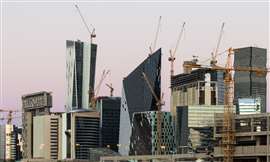Read this article in Français Deutsch Italiano Português Español
Fast friends: are improving US-Saudi relations leading to a contracts bonanza?
17 September 2024
US-Saudi construction-based relations are clearly on the upswing, as Saudi Arabian dignitaries travelled to the US last month to sign a strategic partnership with a prominent US homebuilder. The deal between Hovnanian Enterprises and the Kingdom’s Ministry of Municipalities and Housing (MMH) is just the latest among billions-worth of work between the nations.
 High-rise construction at King Abdullah Financial District in Riyadh, Saudi Arabia. (Image: Adobe Stock)
High-rise construction at King Abdullah Financial District in Riyadh, Saudi Arabia. (Image: Adobe Stock)
The memorandum of understanding is between the MMH and New Jersey-based K. Hovnanian M.E. Investments, a subsidiary of Hovnanian. It was signed on 21 August in the US.
The company said the agreement will conduct joint workshops and prepare executive studies to expedite housing projects with more efficiency. Hovnanian noted the agreement aligns with supporting Saudi Arabia’s Vision 2030 – a Kingdom initiative meant to reduce the country’s dependence on oil, diversify its society and economy, and improve infrastructure by 2030.
What’s driving increases in US-Saudi construction deals?
 A rendering of The Line, Saudi Arabia’s plans for a linear city. (Image courtesy of NEOM)
A rendering of The Line, Saudi Arabia’s plans for a linear city. (Image courtesy of NEOM)
The Hovnanian-Saudi housing understanding is but one example of the budding relationship between American construction firms and Saudi Arabia.
While residential building activity has been mixed globally, Albara’a Alwazir – US-Saudi Business Council (USSBC) director of economic research – told Construction Briefing the sector is booming in Saudi Arabia.
“Real estate has seen exponential growth the last two years, climbing to US$17 billion in 2022 and $22 billion in 2023. By the end of the first quarter of 2024, the real estate sector witnessed $7 billion in awarded contracts, on pace to surpass 2023’s total,” he said.
But real estate and residential are nowhere near the largest segments for Saudi Arabia construction nor US-Saudi cooperative builds.
“One of the most important sets of information to highlight regarding US-Saudi business relations in the construction sector, based on [first quarter] data, is the significant involvement of US companies in Saudi Arabia’s major infrastructure and construction projects,” Alwazir said.
He confirmed the volume is partly explained by the Saudi government’s increased pressure to deliver on Vision 2030, but highlighted major projects, as well, including the FIFA World Cup in 2034.
The result is immense levels of construction activity.
 Progress on The Line Neom in Saudi Arabia visibile from an aerial shot. (Image courtesy Neom)
Progress on The Line Neom in Saudi Arabia visibile from an aerial shot. (Image courtesy Neom)
“This partnership is a key aspect of the broader economic ties between the two countries. US companies have been increasingly active in providing expertise, technology, and capital for Saudi Arabia’s ambitious construction projects under Vision 2030. This includes their participation in mega projects like Neom, the Red Sea Project, and various urban development initiatives,” he said.
Alwazir said US firms’ advanced technology capabilities have also brought the two countries together to meet the Saudis’ ambitious developments.
“The collaboration extends beyond traditional construction to include smart city technologies, sustainable building practices, and advanced infrastructure solutions, areas where US firms have strong capabilities,” said Alwazir.
Oil & gas projects, Neom a big chunk of US-Saudi collaborative work
In its 2024 first quarter (Q1) contract awards index report, the USSBC broke down the breadth of work.
“In terms of value, the oil and gas sector grew significantly during Q1,” said Alwazir, explaining that “oil and gas contracts, by nature, have larger contract values than average. Hence, when numerous contracts are awarded, they tend to dominate the share of awarded contracts by value.”
On Neom – the mind-boggling futuristic urban development that could cost more than $1.5 trillion – Alwazir said, “According to our research, Neom awarded approximately $6.4 billion worth of contracts during the first quarter of 2024 alone. This comes after Neom awarded approximately $13 billion in awarded contracts in 2023. So, it would appear that Neom is on pace to surpass 2023’s total.”
Diving into USSBC data
The report stated that the majority of contracts were awarded in the Eastern Province (45%), led by Saudi Aramco’s Master Gas System and Natural Gas Liquids Recovery Project work.
Other high-volume regions included: Tabuk led by the Neom’s Trojena project (accounting for 21% of contract awards over the period); Makkah (14%), which includes a Downtown Jeddah scheme and a build for a Ceer’s auto plant; and in Riyadh (14%), which has had a robust real-estate sector as the Kingdom’s capital and largest city.
The USSBC contract awards index (CAI), which is measured by “points” representing a ratio of time and value using a 12-month moving average, more than doubled from 2020. A value reading over 100, said USSBC, indicates sector expansion while sub-100 values indicate potential contraction.
The most recent CAI performance reading came in at 415.89 points. The USSBC said 2024’s awards were the at the highest level in 11 years (dating back to the third quarter of 2013).
Year on year, USSBC said the value of awards “soared” in the first quarter to $32 billion, a 79% rise. From the fourth quarter of 2023 to Q1 2024, the USSBC said contract value grew 35%.
The quarter’s success was driven largely by contracts in oil and gas ($13.7 billion), real estate ($6.5 billion) and water ($6.4 billion). These three segments combined represented 84% of US-Saudi work, with oil and gas at 43% of contracts, real estate 21% and water work 20%.
“Other contributing sectors that garnered large projects awards included industrial, urban development and transportation,” said USSBC.
The report expected high-value contract between US and Saudi construction firms will continue despite lower oil revenues requiring ‘recalibration’ of some Vision 2030 plans.
“The role of the PIF will also continue to elevate the number and value of projects in the Kingdom across a wide spectrum of sectors and with domestic investments worth $40 billion annually,” said the report. PIF is the Saudi’s Private Investment Fund, the world’s largest sovereign wealth fund with assets valued just less than $1 trillion.
What do the US and Saudi Arabia gain from collaborative construction?
For the US, Saudi Arabia represents a largely untapped market for builders and contractors. The Kingdom has also committed billions of dollars to major infrastructure and construction schemes, making obtaining work there more desirable than ever before.
For the Saudis, inviting more foreign professionals into its construction industry is helping fast forward the country’s progress on its major development plans. Added to it, the currency of knowledge and experience from outside the Kingdom is helping local construction workers learn new skills, suggested the USSBC report.
“Foreign contractors have significantly enhanced the construction sector by bringing advanced construction techniques and project management skills,” said USSBC. “These collaborations are vital for the successful execution of large-scale developments and the training of local workers, thereby enhancing the skills of the Saudi labour force.”
STAY CONNECTED


Receive the information you need when you need it through our world-leading magazines, newsletters and daily briefings.
CONNECT WITH THE TEAM











